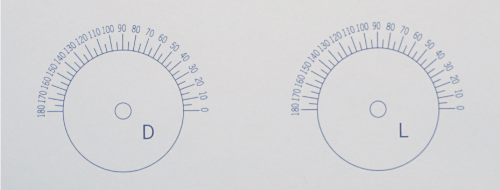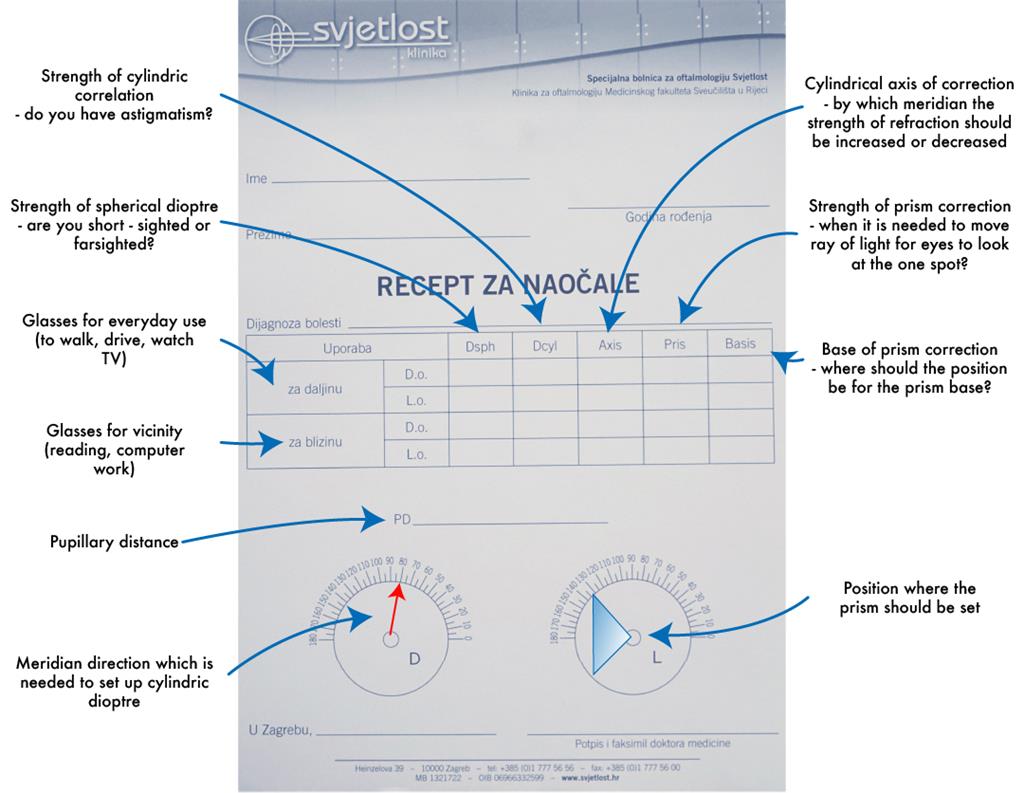How many times have you left ophthalmology examination holding a prescription for glasses, not knowing what the meaning is behind all those written numbers?
Do you have short-sightedness or farsightedness or perhaps you have astigmatism?
How many times have you left ophthalmology examination holding a prescription for glasses, not knowing what the meaning is behind all those written numbers? Do you have short-sightedness or farsightedness or perhaps you have astigmatism?
Do you have short-sightedness or farsightedness or perhaps you have astigmatism?
Eyeglasses prescription has various abbreviations, hopefully, after this blog, it would be easier for you to read them.
In the beginning, there is your name and surname written along with the date of birth. Following a diagnosis is written refractive error(s) of an eye. It can be short-sightedness (myopia), farsightedness (hyperopia), astigmatism (astigmatisms), age-related farsightedness (presbyopia).
Afterward, it usually follows a summary with many deviations such as: OD, OS, OU, Dsph, Dcyl, Axis, Prism, basis, PD... what does all of this mean?
The right eye is in prescription mostly marked with Latin abbreviation OD = oculus dexter, while the left eye is marked as OS = oculus sinister. Somewhere one can simply find abbreviations written in Croatia D.O.-meaning right eye and L.O.-left eye instead of Latin abbreviations.
This is followed by the abbreviation Dsph = Diopter Sphere (sphere, sph), it refers to the power of the lens you need. It can have a plus and minus sign. Having a MINUS sign in front of a number in this field means that you are SHORT-sighted and you need to DECREASE the overall refractive power of your eye to get a clear picture. If you have a PLUS sign in front of a number in this field, then you are FAR- sighted and then it is necessary to increase the overall refractive power of your eye with your glasses so you can see clearly.
Next, you will see Dcyl I Axis (Ax). Cylinder diopter is the sign of the cylinder lens used for the correction of astigmatism. If there is something written at this spot it means you will have increased (sign plus) or decreased (sign minus) the refractive strength of one meridian (solely in one particular direction). The cylinder is followed by Ax=axis, the axis along which is needed a cylindrical lens to be added. At the prescription, it looks like a protractor and the purpose is to display a particular axis. (Picture 1).
 Picture 1. Meridians concerning the eye.
Picture 1. Meridians concerning the eye. If this field is left blank it means you don't have spherical or cylindric diopter, or their deviations from the norm are insignificant and you don't need special glasses for this kind of diopter.
The next two columns (Pris, Basis) are related to the prism correction. Prism is used slightly less frequently so usually; these fields are left blank. The prismatic glass moves the air towards the base, and they are prescribed when the aim is to move to see the direction of one or both eyes
(binocular vision, sort of strabismus, so-called squinting or nystagmus or eye blinking).
The column Pris indicates the strength of the prism lens needed for the patient and Basis side on which optician needs to put prism base. Prism has to be switch inwards (nasal- on the nose), outward (temporary), up or down. Doctors tend to write where the base should be placed.
All of this diopter can be found inside the glasses for distance and nearby.
People under the age of 40 usually need optical glasses for distance and nearby, and when over 40 years they usually need two different diopters for nearby and distance, or glasses for nearby which is in the prescription put in different, separated rows.
The natural lens is losing its elasticity with age, and after 40-45 years one can no longer with ease do long work at the vicinity and that is the sign for so-called age-related farsightedness (presbyopia). In the 40s we need a slight plus diopter for pleasurable work (up to +1,00 Dsph), but that diopter until we are around 65-70 years is increasing (up +3,00 Dsph). These glasses are written at the special row (use at close range).
In the prescription, the space between the pupils in millimeters needs to be listed (PD = pupillary distance).
When a patient needs two pairs of optical glasses you will see two numbers written, it is because when we look at vicinity our eyes reflectively are shifted inwards.

Picture 2 shows Svjetlost Eye Clinic eyeglasses prescription.



